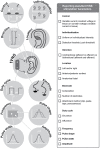International Consensus Based Review and Recommendations for Minimum Reporting Standards in Research on Transcutaneous Vagus Nerve Stimulation (Version 2020)
- PMID: 33854421
- PMCID: PMC8040977
- DOI: 10.3389/fnhum.2020.568051
International Consensus Based Review and Recommendations for Minimum Reporting Standards in Research on Transcutaneous Vagus Nerve Stimulation (Version 2020)
Abstract
Given its non-invasive nature, there is increasing interest in the use of transcutaneous vagus nerve stimulation (tVNS) across basic, translational and clinical research. Contemporaneously, tVNS can be achieved by stimulating either the auricular branch or the cervical bundle of the vagus nerve, referred to as transcutaneous auricular vagus nerve stimulation(VNS) and transcutaneous cervical VNS, respectively. In order to advance the field in a systematic manner, studies using these technologies need to adequately report sufficient methodological detail to enable comparison of results between studies, replication of studies, as well as enhancing study participant safety. We systematically reviewed the existing tVNS literature to evaluate current reporting practices. Based on this review, and consensus among participating authors, we propose a set of minimal reporting items to guide future tVNS studies. The suggested items address specific technical aspects of the device and stimulation parameters. We also cover general recommendations including inclusion and exclusion criteria for participants, outcome parameters and the detailed reporting of side effects. Furthermore, we review strategies used to identify the optimal stimulation parameters for a given research setting and summarize ongoing developments in animal research with potential implications for the application of tVNS in humans. Finally, we discuss the potential of tVNS in future research as well as the associated challenges across several disciplines in research and clinical practice.
Keywords: guidelines & recommendations; minimum reporting standards; transcutaneous auricular vagus nerve stimulation; transcutaneous cervical vagus nerve stimulation; transcutaneous vagus nerve stimulation.
Copyright © 2021 Farmer, Strzelczyk, Finisguerra, Gourine, Gharabaghi, Hasan, Burger, Jaramillo, Mertens, Majid, Verkuil, Badran, Ventura-Bort, Gaul, Beste, Warren, Quintana, Hämmerer, Freri, Frangos, Tobaldini, Kaniusas, Rosenow, Capone, Panetsos, Ackland, Kaithwas, O'Leary, Genheimer, Jacobs, Van Diest, Schoenen, Redgrave, Fang, Deuchars, Széles, Thayer, More, Vonck, Steenbergen, Vianna, McTeague, Ludwig, Veldhuizen, De Couck, Casazza, Keute, Bikson, Andreatta, D'Agostini, Weymar, Betts, Prigge, Kaess, Roden, Thai, Schuster, Montano, Hansen, Kroemer, Rong, Fischer, Howland, Sclocco, Sellaro, Garcia, Bauer, Gancheva, Stavrakis, Kampusch, Deuchars, Wehner, Laborde, Usichenko, Polak, Zaehle, Borges, Teckentrup, Jandackova, Napadow and Koenig.
Conflict of interest statement
EK and SK are employed by company SzeleSTIM GmbH. JS received honoraria from SzeleSTIM GmbH and owns patents in the field of the auricular vagus nerve stimulation. EK, SK, and JS are shareholders of SzeleSTIM GmbH. The remaining authors declare that the research was conducted in the absence of any commercial or financial relationships that could be construed as a potential conflict of interest. The reviewer TS declared a shared affiliation, with no collaboration, with one of the authors HJ, to the handling editor at the time of review.
Figures
References
-
- Afanasiev S. A., Pavliukova E. N., Kuzmichkina M. A., Rebrova T. Y., Anfinogenova Y., Likhomanov K. S., et al. . (2016). Nonpharmacological correction of hypersympatheticotonia in patients with chronic coronary insufficiency and severe left ventricular dysfunction. Ann. Noninvasive Electrocardiol. 21, 548–556. 10.1111/anec.12349 - DOI - PMC - PubMed
-
- Antonino D., Teixeira A. L., Maia-Lopes P. M., Souza M. C., Sabino-Carvalho J. L., Murray A. R., et al. . (2017). Non-invasive vagus nerve stimulation acutely improves spontaneous cardiac baroreflex sensitivity in healthy young men: a randomized placebo-controlled trial. Brain Stimul. 10, 875–881. 10.1016/j.brs.2017.05.006 - DOI - PubMed
Publication types
Grants and funding
LinkOut - more resources
Full Text Sources
Other Literature Sources
Medical



